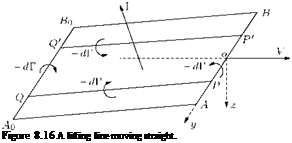The Lift for Elliptic Loading
From Equation (8.43), we have:
![]()
|
|
|
|
|
|
|
|
|
|
|
|
|
|
|
|
|
|
|
Lift and Drag Calculation by Impulse Method
 |
Let us consider an aerofoil, regarded as a lifting line AB, started from rest and which moves in a straight line. Let the velocity be V at time t. Let at time t the starting vortex be assumed to be A0B0, as shown in Figure 8.16.
Let us assume that the wake ABA0B0 remains as a rectangular sheet, as shown in Figure 8.16. If P is the point (0, y, 0) and Q is the point (-l, y,z). The flow from point P reaching the line A0 B0 experiences a circulation of – dk(y) [Equation (8.1)]. Therefore the whole wake may be regarded as resulting from the superposition of vortex rings, a typical one being PP’ QQ of circulation – dk(y).
Let PQ = h. The area of the ring is 2yh. If n is the unit normal to a small area dS separating points P and Q, the impulse on this area due to impulsive pressure is:
—npфPdS at P and + npфQdS at Q,
where:
ФQ – фp = drc = k,
where c is any circuit joining points P and Q and not intersecting the plane containing P and Q. Thus the resultant linear impulse on the system is the vector:
I = I p (фq — фP) ndS = I pkndS = pkSn.
Js J S
Thus the impulse for the area (2yh) of the vortex ring, with n as the unit normal to the plane rectangle, is:
dl = p [—dk(y)] 2yhn = pdk(y) ■ 2y (kl + iz),
since —hn = kl + iz, by geometry. The impulse I of the whole wake is:
[ 2ydk(y) = f ydk(y) = [yk(y)] + — f k(y) dy.
J OA J BA J-b
Thus:
|
/ |
+b
p (kl + iz) k(y) dy.
The time rate of change of the impulse gives the force. Therefore the aerodynamic force is dl/dt and dl/dt = V, while dz/dt = w, the normal velocity at Q, which by symmetry of the ring is equal to the downwash velocity at P. Thus the aerodynamic force is:
|
/ |
+b f‘ +b
pVk(y) dy — i pwk(y) dy,
b J —b
which consists of the same lift and induced drag as were calculated by Prandtl’s hypotheses.
The method of the impulse is applicable whatever the form of the wake.











